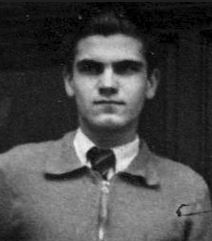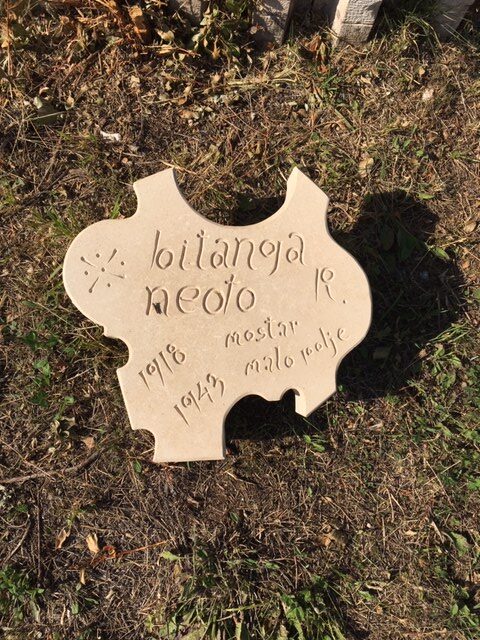
brochure "Partizanski spomenik u Mostaru" (1980)
book “Spomenica Mostara 1941-1945.”
another document or proof of the memorial stone (e.g., a photograph).
Neđo R. BITANGA
NEDJELJKO NEĐO BITANGA, son of RADOSLAV, born on April 14, 1918, in Mostar, auto mechanic, trade unionist, member of the Communist Party of Yugoslavia (KPJ) since 1936. Son of the veteran communist Rade Bitanga, one of the founders of the KPJ in Mostar and a collaborator of Gojko Vuković, and Darinka Bitanga who were hanged in Mostar in November 1943. Member of the Local Committee of the KPJ for Mostar and the Military Commission (military commission composed of: Jusuf Čevro, Neđo Bitanga, and Vasko Gnjatić) with the task of organizing communication with the field, creating channels for the departure of fighters and transportation of materials to the field; maintaining courier connections with the field and cities in Herzegovina, as well as connections with the Provincial Committee in Sarajevo and the Regional Committee in the field. First fighter, in the Battalion since mid-August 1941. He was part of a group of fighters that, between August 15 and 20, 1941, formed a detachment led by Savo Medan. They set off after 9 p.m. from the Bjelušine neighborhood, armed with 16 rifles, 150 rounds per rifle. Each fighter had a revolver and at least two “Kragujevac” rifles. Company commissar. In late 1942, he was sent to Mostar, according to witnesses, due to a lack of physical condition. In Mostar, he was preparing an armed attack on the Ustasha commander Barbarić. When he was returning to the detachment on April 26, 1943 (from the Lower Mahala towards Baćevići and across the Neretva), the enemy surprised Neđo’s group in the area of Petka near the village of Buna. Neđo was surrounded, he defended himself with a pistol (according to some sources, he was wounded), and when he ran out of ammunition, to avoid falling into the hands of the enemy, he threw a grenade under himself and died. He was described as a “beloved fighter.”
Excerpts from the literature:
On the return to Mostar:
“I remember that some comrades, considering that they had lived illegally for a long time, had very poor physical condition, and they had difficulty moving, thus slowing down the march of the detachment. For example, Neđo Bitanga was constantly falling behind, and since he couldn’t continue, it was decided that he would return to Mostar from Podveležje. Someone had to accompany him because he had difficulty moving. Hasan Bubić went with him, and later I learned from him how they returned to Mostar. They had to move during the day. For camouflage, Hasan Bubić, armed with a rifle as an ‘Ustasha,’ escorted Neđo tied up towards Mostar. When they were close to the city, he untied him, they waited for dusk, and then entered Mostar.”
On Neđo’s death:
“The first group set off from Mostar, from Donja Mahala, from the house of Zineta Sehović and Memnuna Hadžiosmanović, during the night of April 25/26, 1943, towards Dubrave. The group consisted of: PETAR KRAJINA, the group leader, NEĐO BITANGA, MUHAMED BOSTANDŽIĆ, ŠERIF BURIĆ, ZAJKO ĆUSTOVIĆ, MUHAMED GREBO, SALKO HADŽAJLIĆ, SLAVKO IVANIŠEVIĆ, ABID VOLODER, GOJKO RADE VUKOVIĆ, SLOBODAN ZUROVAC, and ŠEFKIJA ZULJEVIĆ. The group was armed with 4 pistols and hand grenades. Upon arriving in Bačevići, they were transported across the Neretva River by boats and headed towards Akšam’s Grove on the Petak elevation near the Buna River for rendezvous. However, the guides did not arrive, so the group waited until dawn and then took shelter deeper into the forest. When the owner of the forest, Dušan Akšam, passed by, the group detained him, but due to the negligence of some comrades, he managed to escape. Uncertain if he would report them, it was decided that the group would proceed to Dubrave. Soon after, they were attacked by Chetniks, Muslim Ustasha militia, and Italians. The command was given to flee in all directions to at least save someone. Bostandžić, Burić, and Ćustović returned to Mostar via Bišće and avoided capture, while Voloder returned alone. All others were captured. Grebo and Hadžajlić were wounded and taken to an Italian hospital for treatment. Neđo Bitanga, surrounded, defended himself with a pistol, and when he ran out of ammunition, he activated a hand grenade and placed it beside him to avoid capture, shouting ‘Long live Stalin!’ and ‘Long live the Communist Party of Yugoslavia!'”
Ćemalović, Enver (1986): Mostarski bataljon, Mostar; Deseta Hercegovačka brigada (spisak boraca) ; grupa autora (1961): Hercegovina u NOB 1. dio, Beograd, Vojno delo; Konjhodžić, Mahmud (1981): “Mostarke”: fragmenti o revolucionarnoj djelatnosti i patriotskoj opredjeljenosti žena Mostara, o njihovoj borbi za slobodu i socijalizam, Opštinski odbor SUBNOR-a Mostar; Seferović, Mensur (1958): “Bataljon u okupiranom gradu”, Sarajevo; grupa autora (1961): Hercegovina u NOB 1. dio, Beograd, Vojno delo; grupa autora: Spomenica Mostara 1941-1945.
Photo of the memorial plaque: S. Demirović; photo of the fighter: “Partizanski spomenik u Mostaru” (unconfirmed).
Do you have more information about this fighter? Share your stories and photographs. Let's keep the memory alive!




